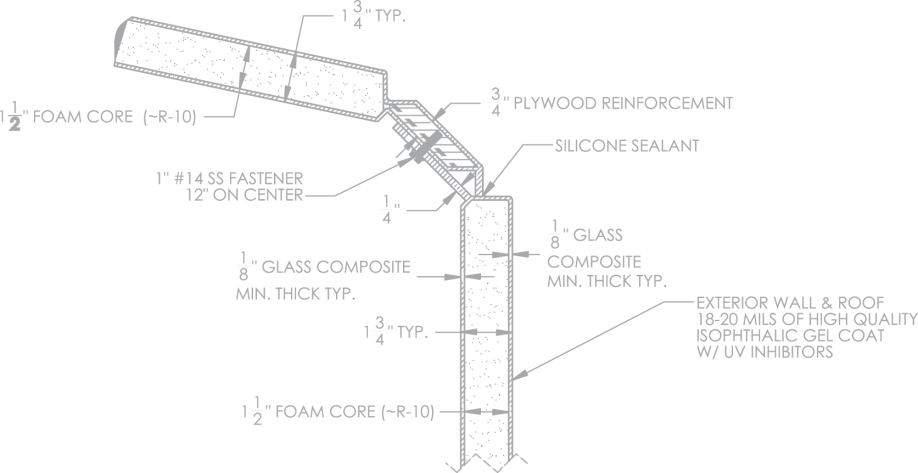Opening the Environmental Advantages of Recycled Compounds in Building and Design
In the realm of building and style, the use of recycled compounds holds substantial assurance for boosting sustainability techniques and reducing ecological influence. The change towards a much more lasting future in these industries hinges on opening the complete possibility of recycled compounds.

Environmental Effect Reduction
The reduction of ecological effect through making use of recycled compounds in building and construction and design plays an important role in lasting methods. By integrating recycled composites right into building products, the building and construction market can substantially decrease its carbon impact and add to a more eco-friendly future. These lasting products, made from repurposed plastics, timber fibers, or various other recycled aspects, offer a sensible option to conventional building and construction materials without compromising on high quality or resilience.
Recycled compounds assist divert waste from land fills and decrease the demand for drawing out raw materials, therefore saving natural resources. In addition, the production process of these compounds typically consumes less power and sends out fewer greenhouse gases contrasted to producing virgin materials (composites). This change towards making use of recycled composites not just minimizes environmental injury but likewise advertises a circular economy by encouraging the reuse of materials that would certainly otherwise be disposed of
Waste Reduction
With a focus on lessening waste in construction and style, the assimilation of recycled compounds provides a lasting remedy to decrease ecological impact. Waste minimization is a critical element of sustainable techniques, and using recycled composites offers an opportunity to achieve this objective properly. By utilizing products that have actually already served their preliminary function, such as recycled plastics or redeemed timber fibers, the construction and style sectors can considerably minimize the quantity of waste created and sent out to land fills.
Recycled compounds have the possible to draw away substantial amounts of waste from conventional disposal techniques, adding to a much more circular economic climate where sources are used efficiently. Additionally, the manufacturing procedure of recycled composites typically takes in less energy and produces fewer emissions contrasted to virgin materials, even more minimizing the ecological footprint of construction and design tasks.
Implementing waste reduction approaches via the consolidation of recycled composites not only aids in preserving natural deposits but also advertises an extra sustainable method to building and designing for a greener future.
Power Preservation
Integrating recycled composites not just lessens waste in building and design yet additionally plays a crucial duty in improving energy preservation practices within the sector. Using recycled composites in building and construction can dramatically add to energy preservation with various ways. The manufacturing of virgin materials typically needs substantial energy inputs, whereas using recycled compounds takes in much less energy, therefore decreasing total energy intake. Additionally, including recycled compounds can add to much better insulation residential properties in buildings, lowering the need for extreme heating or cooling, and consequently reducing power usage for environment control. The lightweight nature of several recycled compounds can lead to lighter structures, requiring less power for transport and installment. By promoting using recycled compounds in construction and style, the sector can make considerable strides in the direction of achieving power performance and reducing its carbon footprint, ultimately contributing to an extra sustainable developed setting.
Carbon Impact Decrease
Enhancing sustainability methods with the usage of recycled composites in building and construction and layout substantially minimizes the carbon footprint of the sector. By including recycled products right into the published here production of composites, the demand for virgin sources decreases, leading to reduced power usage and greenhouse gas emissions associated with traditional production processes. This decrease in carbon impact is vital in combating climate adjustment and promoting a more eco-friendly strategy to building and design.
In addition, using recycled compounds likewise helps in diverting waste from land fills, consequently reducing the ecological effect of disposal and advertising a circular economy. The carbon impact reduction attained through the fostering of recycled composites straightens with the international push in the direction of sustainable methods and the reduction of commercial emissions. It showcases a dedication to responsible source management and a change in the direction of greener options in the construction and layout industries. Eventually, by prioritizing the assimilation of recycled compounds, the market can make substantial strides in reducing its carbon footprint and contributing to a much more lasting future.
Lasting Future
The combination of recycled composites in construction and layout not only addresses prompt environmental issues however also lays a strong structure for a sustainable future in the sector. By integrating recycled compounds into building materials and items, the building and layout fields can substantially decrease their reliance on virgin resources, causing an extra circular economic situation. This shift in the direction of sustainability is essential for minimizing the environmental influence of traditional building techniques, which typically cause high degrees of waste generation and resource depletion.

Verdict
Finally, recycled compounds supply substantial ecological advantages in building and style by minimizing environmental impact, reducing waste, conserving energy, lowering carbon impact, and advertising a lasting future. Accepting using recycled composites can add to an extra environmentally-friendly technique to building and layout, eventually causing an extra lasting and greener future for all.
The reduction of environmental influence via the use of recycled composites in construction and layout plays a critical function in sustainable techniques.With an emphasis on reducing waste in construction and style, the visit their website assimilation of recycled composites supplies a lasting service to reduce environmental impact. By advertising the use of recycled compounds in building and design, the sector can make considerable strides towards accomplishing energy efficiency and reducing its carbon impact, eventually contributing to a much more sustainable constructed atmosphere.

Comments on “Composites: The Future of Lasting Building Products”